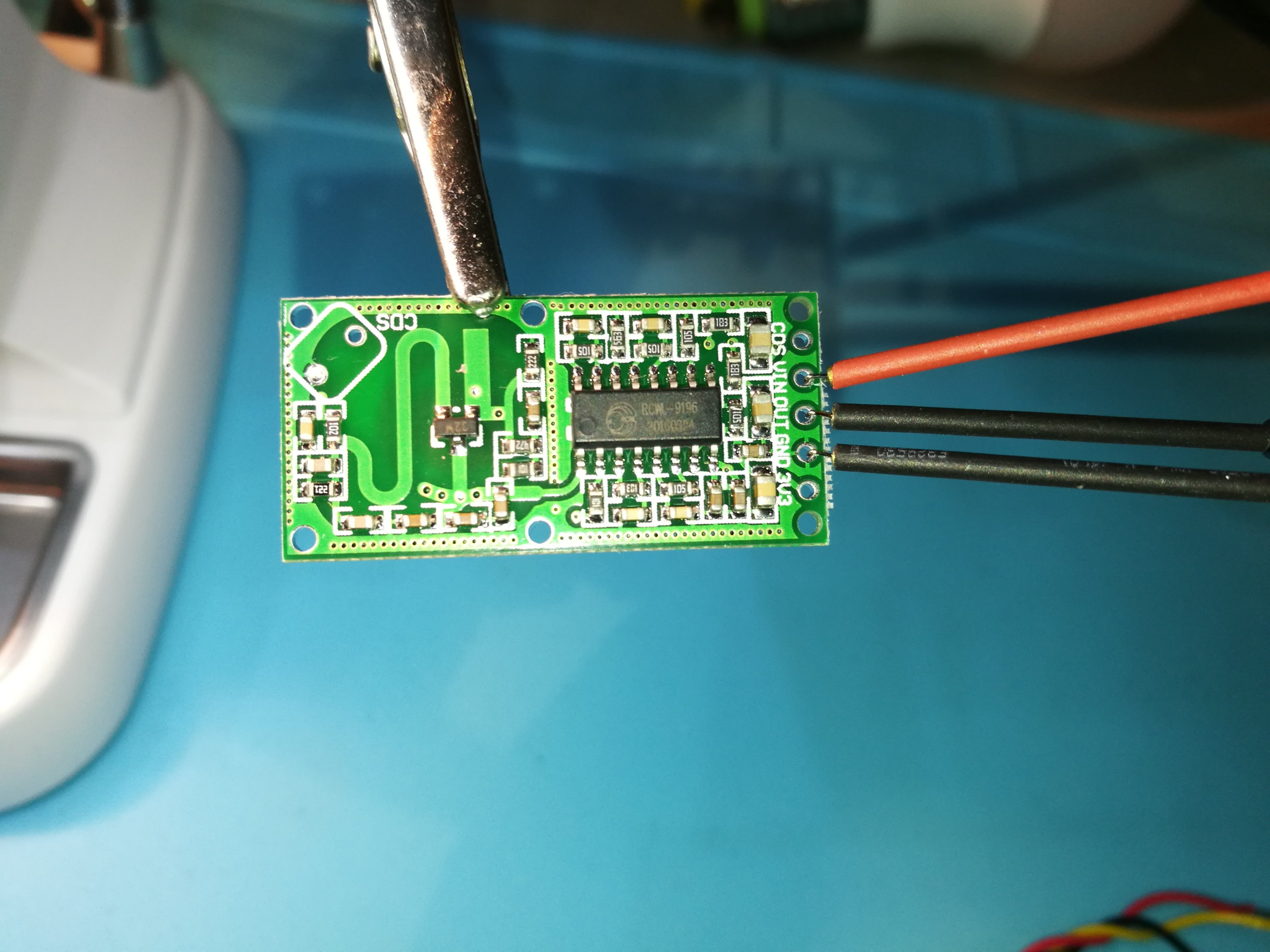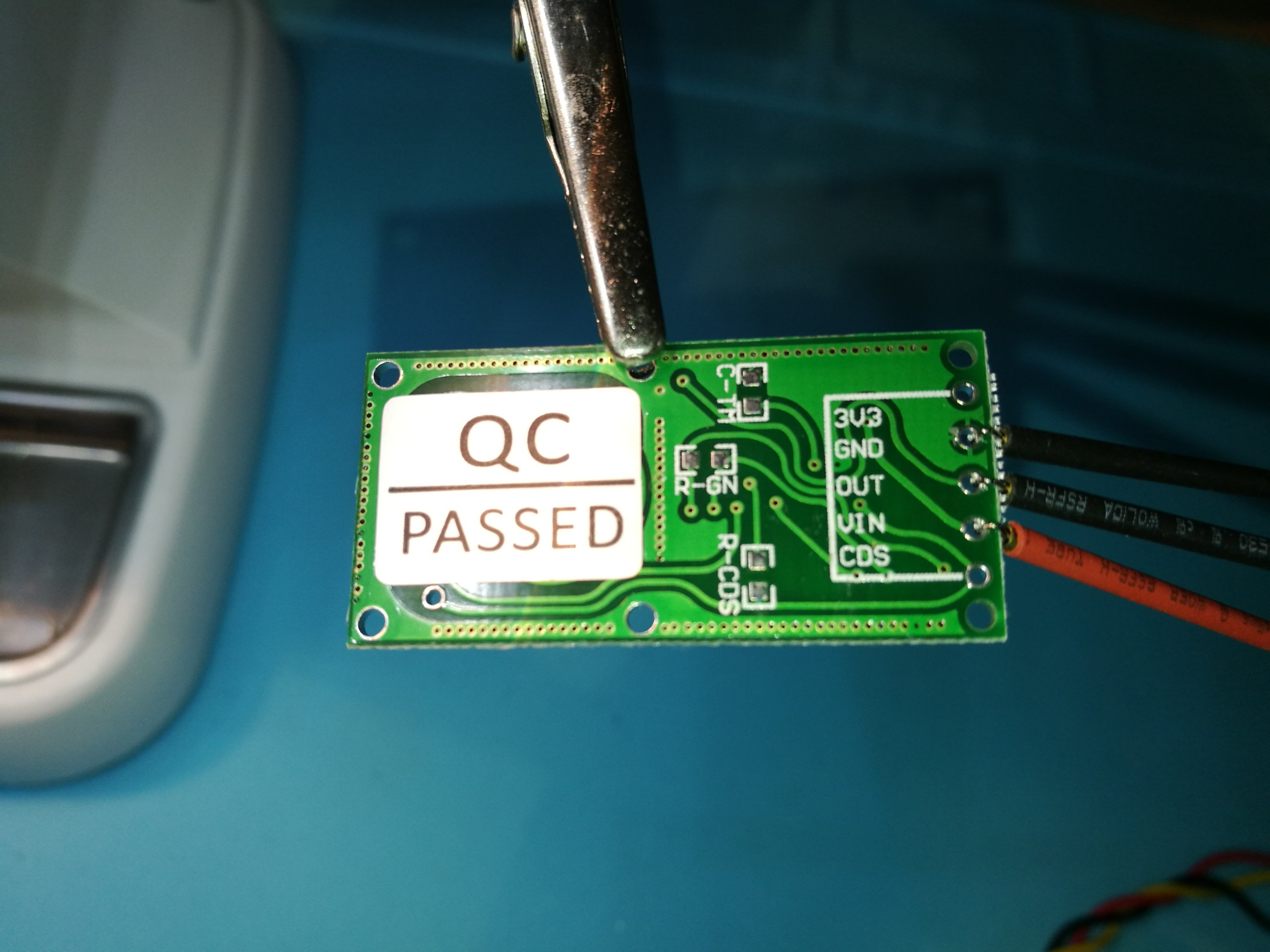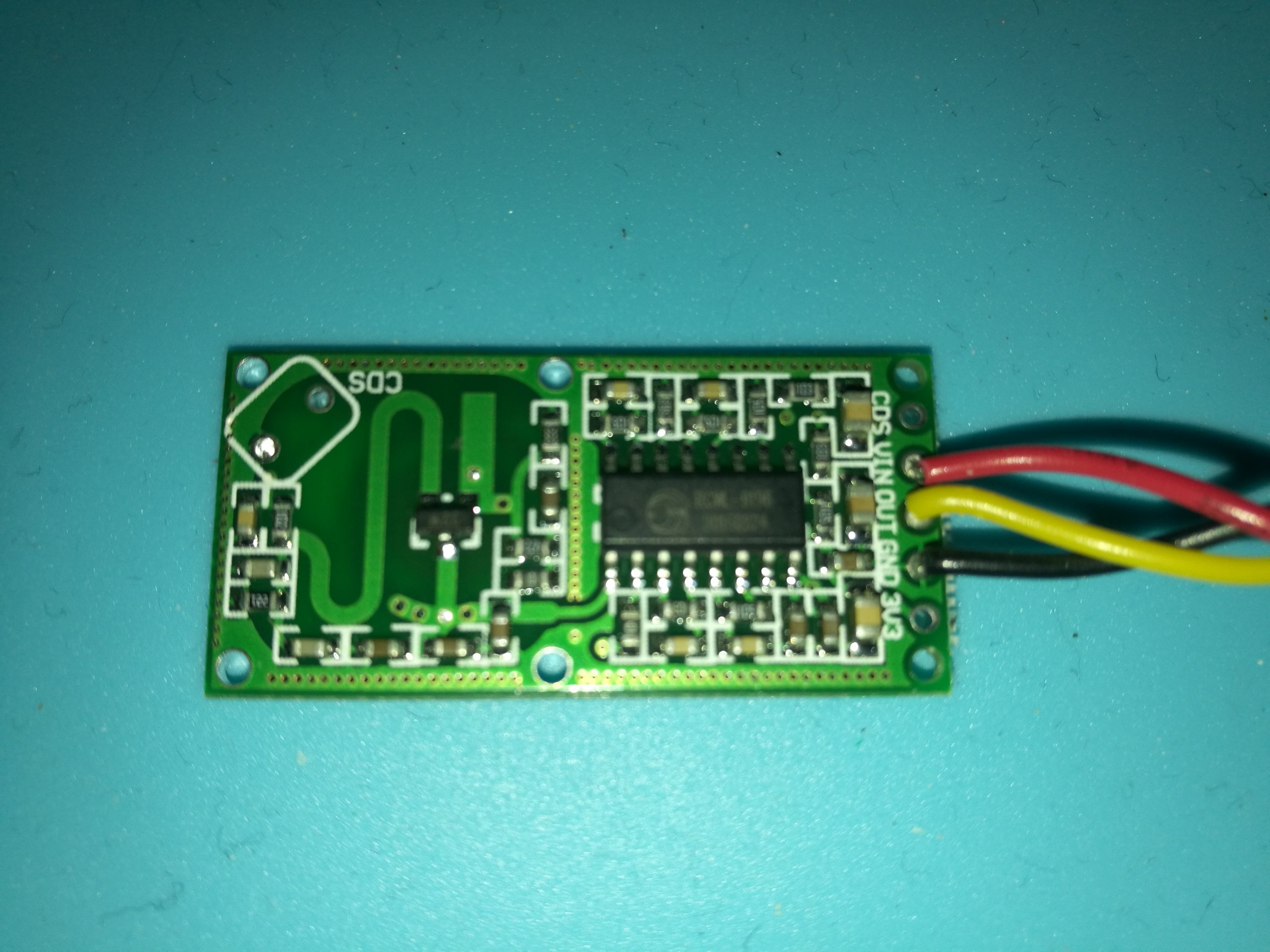I needed a motion detector for Arduino. I saw a cheap Microwave Radar Induction Switch Human Motion Sensor Module at DX (similar also available at Banggood at pack of 5). It advertises High Sensitivity for Arduino, Long Sensing Distance, Wide Sensing Angle for Detecting Moving Objects.

Using this is a microwave sensor module that specifically for detecting moving objects and human body. It uses uses Doppler radar technology, a technology that I tested with other module at my HB100 microwave radar to Arduino posting. This module promises advantages such as high sensitivity, long sensing distance, wide sensing angle, high reliability, wide range of operating voltage. It is designed to be used in human body sensing lighting system and anti-theft alarm system (as an alternative to the common PIR motion sensors).
The working voltage range is 4-28VDC with operating current less than 3 mA. The module outputs 3.3V digital signal that is on or off based on detection. Those specifications are such that the module can be directly interfaced to Arduino board that used 5V voltage (connect GND / OUT / VIN). . That 5V is right operating voltage for module, and the 3.3V digital output works OK with Arduino AVR chip operating at 5V digital input. The module has also 3.3V regulator that did not test.
The module promises detecting range of less than 120 degrees taper angle within 7 meters. The module works well up to few meters distance (I did not try longer distance). The trigger mode s repeat trigger and the delay time is 2 seconds (option to change value). When this radar module triggered by moving object, its TTL-level output (OUT) pin switches from LOW (0 V) to HIGH (3.3 V) for a finite time (around 2 seconds) before returning to its idle (LOW) state.

Soldered wires

Pinout:
3V3……….Regulated output (reference only)
GND………Ground / 0V supply input
OUT……….Trigger: HIGH (3.3V) motion detected / LOW (0V) idle
VIN………. 4V-28V supply input
CDS……….Sensor disable input (pull low to disable)
Here are some videos on this and similar radar modules:
Amazing $1 microwave RF motion sensor board review and test
Coolest motion detection sensor ever!
#135 Radar Sensors / Switches: Comparison and Tests
Doppler Radar – and how it works
RCWL-0516 Microwave Radar Sensor Arduino Distance Test and Review
How this device electronics works? It was a little hard information available for this (eg even the operating frequency is left unstated on product page). But after some Google searching I found some useful information bits.
Electroschematics RCWL-0516 page gives some details on the technology of the module:
Supply Voltage: 4–28 VDC
Operating frequency: ~3.2 GHz (observed by me at my lab)
Transmit power: 20 mW (typical)/30 mW (max)
Sensing Distance: 5–7 m
Stackexhange posting on rcwl-0516 module tells that the operating frequency is 3.181GHz! RF part of this has surprisingly few components (what looks like a MMBR941M NPN and a hand full of passives) and the microwave magic could be in the PCB design. There is a GitHub repository on module information at https://github.com/jdesbonnet/RCWL-0516. Also Hackaday has some information on this module.
MPJA page says that this detects human motion even thru an interior wall! Range about 20 feet, bigger objects perhaps further. Hobbycomponents page says that HCSENS0040 device operates at ~3.2GHz/20 – 30mW. In some countries it may be illegal to operate this device. Component side should face detection area for maximum sensitivity. Do not place metal objects within 1cm of antenna. I am not sure would this device fall within ETSI Short Range Devices definitions and would the used frequency OK to use.
Investigating a RCWL 9196 / RCWL-0516 “Radar” motion detector module page provides this nice circuit diagram of the device (similar to one on this data sheet):
Based on the schematics – the transistor works as a free running UHF oscillator, the changes in its collector current are filtered by R3 C9 low pass filter and fed into the chip. Whatever the chip does, it is quite simple design.
A microwave frequency transmitter/receiver/mixer and a much lower frequency part based on an IC (marked RCWL-9196) which is very similar to the BISS0001 IC used in PIR motion detectors. For idea how the microwave part of this works, check the patent EP3091605A1 that describes similar device that operates at 5.8 GHz. At the heart of the RF is a Q1 a MMBR941M high frequency NPN transistor in what is probably a Colpitt oscillator confguration and works as mixer for difference between the transmitted and reflected signal. The core of the low frequncy signal processing is an IC marked RCWL-9196. For some more details, check this RCWL-0516 document.

23 Comments
Tomi Engdahl says:
The still unanswered question is that would using this device be legal as small power radar?
Or is this considered as illegal RF noise source that disturbs something important?
Tomi Engdahl says:
Intelligent Sensors using 24GHz Radar Technology
https://www.arrow.com/en/research-and-events/videos/the-top-10-development-platforms-dev-kits-2018
Getting started with Infineon’s development kit SENSE2GOL
Infineon’s range of radar offerings provide unique benefits not possible with traditional motion sensing technology (passive infrared technology, camera based systems) such as increased range coverage, small form factor solution or object detection while keeping identities anonymous.
The BGT24LTR11 can be found at the heart of Infineon’s radar sensor portfolio. Synonymous with ultra-low power sensing using a new generation of 24GHz radar technology it operates perfectly also under harsh (weather) conditions. The low power radar transceiver combines one transmit and one receive channel. It is currently the smallest 24 GHz MMIC in the market.
Tomi Engdahl says:
HFS-DC06 5.8GHz Microwave Radar Sensor Module DC 5V ISM Waveband Sensing 12M
https://m.banggood.com/HFS-DC06-5_8GHz-Microwave-Radar-Sensor-Module-DC-5V-ISM-Waveband-Sensing-12M-p-1250518.html?currency=USD&utm_source=facebook&utm_medium=cpc_elc3&utm_campaign=elc-dpadm-en-fb1-RSM-mob-cro14&utm_content=may&utm_ho=18+
Tomi Engdahl says:
People Counting and Tracking Reference Design Using mmWave Radar Sensor
http://www.ti.com/tool/tidep-01000?HQS=epd-pro-rap-60GHzLaunch-csbs-rd-ElectronicDesign-wwe&DCM=yes
This reference design demonstrates the use of IWR6843, which is a single-chip mmWave radar sensor with integrated DSP for an indoor and outdoor people counting application. This reference design uses the IWR6843ISK evaluation module (EVM) and integrates a complete radar processing chain onto the IWR6843 device. This solution can detect up to 250 objects, and point and track up to 20 people with a field of view (FOV) of ±60º in the azimuth (horizontal) plane.
Tomi Engdahl says:
mmWave IWR – Traffic monitoring
http://www.ti.com/sensors/mmwave/iwr/applications/radar-for-transport.html?HQS=epd-pro-rap-60GHzLaunch-csbs-lp-ElectronicDesign-wwe&DCM=yes
TI’s Industrial mmWave Solutions for traffic monitoring enable detection of traffic and pedestrians through all light and weather conditions, at distances over 100m, and with accurate range and velocity information for intelligent reporting and decision making.
Tomi Engdahl says:
SDR Is At the Heart of This Soup-Can Doppler Radar Set
https://hackaday.com/2018/11/29/sdr-is-at-the-heart-of-this-soup-can-doppler-radar-set/
Want to explore the world of radar but feel daunted by the mysteries of radio frequency electronics? Be daunted no more and abstract the RF complexities away with this tutorial on software-defined radar.
Software Defined Doppler Radar with LimeSDR Mini
https://luigifreitas.me/2018-11-23/software-defined-radar-cw-doppler-radar-with-limesdr
Tomi Engdahl says:
#135 Radar Sensors / Switches: Comparison and Tests
https://www.youtube.com/watch?v=9WiJJgIi3W0
Links:
HW-MS03: http://bit.ly/2qffo0R
RCWL-0516 (Works also with 3.3 volts): https://www.aliexpress.com/item/RCWL-…
WB3-12: https://www.aliexpress.com/item/LED-M…
XYC-WB-D1: https://www.aliexpress.com/item/Micro…
HFS-DC06: https://www.aliexpress.com/item/5-8GH…
220V Switch (SK-600): http://bit.ly/2oGt8Sc
Information about RCWL-0516 microwave proximity switch module (ICStation.com SKU 10630)
https://github.com/jdesbonnet/RCWL-0516/
Tomi Engdahl says:
Investigating a RCWL 9196 / RCWL-0516 “Radar” motion detector module
http://www.rogerclark.net/investigating-a-rcwl-9196-rcwl-0516-radar-motion-detector-modules/
Information about RCWL-0516 microwave proximity switch module (ICStation.com SKU 10630)
https://github.com/jdesbonnet/RCWL-0516/
Tomi Engdahl says:
Inside a sealed Chinese Solar street light with Doppler detection.
https://www.youtube.com/watch?v=kGi7Y-mB_OY
Tomi Engdahl says:
https://hackaday.com/2018/05/03/robot-radar-module/
Tomi Engdahl says:
RCWL-0516 Microwave Proximity Sensor – With & Without Arduino
https://www.youtube.com/watch?v=IJoPkKlxFXA
The RCWL-0516 is an inexpensive proximity sensor that works using microwaves and Doppler Radar. It can be used on its own or with an Arduino, I will show you both ways.
Tomi Engdahl says:
Yet Another Doppler Direction Finder w/ Teensy DSP
https://hackaday.io/project/163957-yet-another-doppler-direction-finder-w-teensy-dsp
An update on WA2EBY’s May/June 1999 QST Homebrew DDF/Radio Direction Finder
Doppler radio direction finder using Teensy audio library DSP to replace switched capacitor filter and random logic. Use a Neopixel ring for a display.
Radio direction finding (RDF) or T-hunting or fox hunting has been a hobby in the ham radio world for a long time. If you’ve ever seen a car equipped with a big, crazy looking antenna, a square antenna array or people running around with funny antennas and radios, they are probably T-Hunting. If it’s a weekend it’s probably hams and a weekday someone looking for a transmitter for another reason.
Tomi Engdahl says:
How microwave body detectors work. With RF section schematic.
https://www.youtube.com/watch?v=Hf19hc9PtcE
When I first took a microwave triggered lamp apart in a video I joked about the hidden chip being a standard PIR body sensor chip – and was then aghast to find that it WAS. Which meant that all the microwave signal generation and movement detection was being done by a single transistor and some cunningly designed PCB tracks.
It’s got strong similarities to the Colpitts oscillator FM micro transmitters I used to make for the 88-108MHz frequencies – not 300MHz as I mentioned in the video.
The chip being used on this breathtakingly cheap and versatile module is a customised BISS0001 with a rarely used pin repurposed as the input to an internal 3.3V voltage regulator. That removes the need for a separate regulator on the PCB.
Tomi Engdahl says:
Teardown: Cobra XRS 9740 Radar Detector
https://hackaday.com/2020/03/18/teardown-cobra-xrs-9740-radar-detector/
The subject of today’s teardown is a perfect example of “Peak Radar Detector”. Manufactured back in 2007, the Cobra XRS 9740 would have been a fairly mid-range entry offering the sort of features that would have been desirable at the time. Over a decade ago, having an alphanumeric display, voice alerts, and a digital compass were all things worth shouting about on the box the thing was sold in. Though looking like some kind of Cardassian warship was apparently just an added bonus.
Tomi Engdahl says:
How to choose Radar Sensors (Tutorial). Incl. PIR and LIDAR
https://www.youtube.com/watch?v=PNbAM9IhfBE
Radar is a valuable technology. Because of its unique features, it not only helped to win world war II. It also can solve many problems in our projects.
Sensors included: RCWL-0516 (3GHz), HB100 (10GHz), CDM324 (24GHz), FM24-NP100 FMCW Radar (24GHz)
These are the questions answered in this video:
- Which Radar sensors exist, and how do they have to be connected to our boards?
- How do they compare?
- How can we use them in our projects?
- Which other technologies exist to solve similar problems?
- And finally, we should have a comparison chart, also including PIR and Lidars
Tomi Engdahl says:
An Engineer’s Guide to Industrial Robot Designs 48 2Q 2020 I Texas Instruments
4.1 TI mmWave radar sensors in robotics
applications
https://www.ti.com/lit/eb/ssiy006/ssiy006.pdf?hqs=sys-ind-fa-rob_robotics21_ssiy006_chp48-agg-ebook-electronicdesign_ind-wwe_int&ts=1660840070307#page=48
Tomi Engdahl says:
https://hackaday.com/2023/01/17/take-a-deep-dive-into-a-commodity-automotive-radar-chip/
Tomi Engdahl says:
https://etn.fi/index.php/new-products/15413-lisaekortti-tunnistaa-liikkeen-dopplerin-ilmioen-avulla
Tomi Engdahl says:
A Millimeter wave motion sensor for home automation, rather small at 44x22mm.
This motion detector uses microwave radar to detect the presence of a person, instead of heat like in passive infra red sensors. The beauty of mmwave sensors is they can detect you when you’re stationary (they detect the small movements of your chest from breathing), so no more waving hands when the lights turn off on you.
Tomi Engdahl says:
https://www.hackster.io/news/seeed-studio-announces-official-esphome-support-for-its-mmwave-presence-sensor-sensecap-indicator-8c2435926cfd
Tomi Engdahl says:
Sparkfun’s Pulsed Coherent Radar Sensor features Acconeer XM125 60 GHz module, works through walls, offers up to 20-meter range
SparkFun has launched a new Qwiic breakout board for the Acconeer XM125 60 GHz pulsed coherent radar sensor that can measure distance to humans even through walls and works at a distance of up to 20 meters.
https://www.cnx-software.com/2024/04/01/sparkfun-pulsed-coherent-radar-sensor-acconeer-xm125-60-ghz-module-works-through-walls-20-meter-range/
Tomi Engdahl says:
So Much Going On In So Few Components: Dissecting A Microwave Radar Module
https://hackaday.com/2024/07/01/so-much-going-on-in-so-few-components-dissecting-a-microwave-radar-module/
https://10maurycy10.github.io/projects/motion_sensor_hacking/
Tomi Engdahl says:
Diving Deep Into the RCWL-0516 Sub-$1 Microwave Radar — and Turning It into an S-Band Transmitter
What lies inside the RCWL-0516? A dual oscillator circuit and, surprisingly, an infrared motion sensor chip, 10maurycy10 finds.
https://www.hackster.io/news/diving-deep-into-the-rcwl-0516-sub-1-microwave-radar-and-turning-it-into-an-s-band-transmitter-cc47b8df3d0d